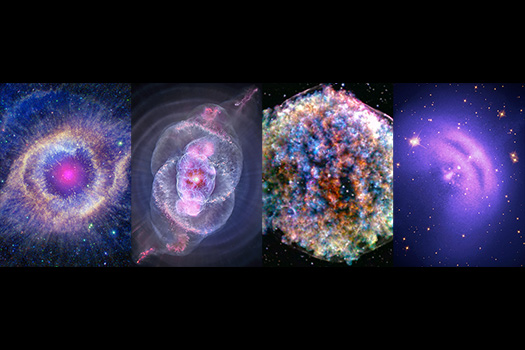Scientists from Brown, NASA and the Smithsonian Bring Cosmic Explorations to Smartphones

A set of new augmented reality (AR) experiences lets users
travel virtually through cosmic objects in 3D.
The following press release from Brown University, being released in conjunction with another from the Smithsonian Institution, highlights an exciting new project that brings cosmic objects in 3D to Instagram “experiences.” This project was led by Dr. Kimberly Arcand of the Smithsonian Astrophysical Observatory that runs the Chandra X-ray Center on behalf of NASA. These new Chandra Instagram experiences are the first ever to include sonifications (translations of data into sound) and represent a new way of making astronomical data more accessible.
By using a phone camera and a new set of Instagram augmented reality filters, anyone can dive into the depths of space, encountering nebulae, pulsars and even remnants of exploded stars.
Gaze at the ethereal colors of distant nebulae. Zoom in to the heart of an exploded star. Listen to chimes, bells and electric rhythms representing a celestial object far off in space. Through new Instagram filters, users of the app can now embark on cosmic journeys through their smartphones with space-themed augmented reality experiences.
The filters are fun, for sure — but they’re also grounded in some serious science. The experiences were created by researchers from Brown University, Smithsonian Astrophysical Observatory and NASA to celebrate the 25th anniversary the Chandra spacecraft, NASA’s flagship X-ray telescope. The goals are to engage the public, make images of space more accessible and add new layers of understanding to some of the most well-known and widely studied objects in the sky.
The project allows users to virtually interact with astronomical objects like Tycho supernova remnant, the Vela Pulsar, the Helix Nebula, the Cat’s Eye Nebula and even the Chandra X-ray Observatory. The project uses data from the Chandra spacecraft and other telescopes for the interactive models, which users can zoom in and out of and make their backdrop for selfies. The imagery is also accompanied by informative text that explains what users are seeing, and data “sonifications” of the celestial objects, which translate the images into sounds.
“Seeing the Crab Nebula over your table is kind of ridiculous, but every time we show that one to somebody, they laugh, they smile, they want to learn more — that kind of engagement is really what this type of project is about,” said Tom Sgouros, a research associate in Brown’s Department of Computer Science. “You never know what spark is going to hit somebody. It’s why I think people who do science have almost a responsibility to get their work out there and try to explain what's so cool about it.”
Under the direction of Sgouros, former Brown graduate student Alexander Dupuis and current undergraduate Healey Koch analyzed 3D models developed by scientists on the Chandra team and then reconstructed the celestial objects so they fit the processing and communication limitations of smartphones. They then rendered those models for Instagram’s augmented reality framework.
"There is a lot of rich and beautiful data associated with these models that Healey and I looked to bring in, which we did by creating the textures on the models as well as programming visual effects for displaying them in AR," Dupuis said.
The effort spanned nearly three years from start to finish and was led by Kimberly Arcand, Chandra’s visualization and emerging technology scientist at the Center for Astrophysics, a collaboration between the Smithsonian Astrophysical Observatory and Harvard College Observatory.
Seeing the end result makes the work well worth it, Koch said. He recommends checking out the 3D model showing Chandra, which is the most powerful X-ray telescope in the sky.
“It's different from the other ones because it's a manmade object,” Koch said. “You’ll be able to see the orbiting platform, foils, solar panels and other shiny things.”
Traditionally, it has been difficult to gather 3D data of objects in space due to their two-dimensional projection on the sky, but new instruments and techniques like the ones Dupuis developed for this project have recently allowed astronomers to construct data-driven models of what these distant objects look like in three dimensions and reduce them to phone size.
In recent years, Instagram experiences of NASA mission control, the International Space Station and the Perseverance Rover on Mars have allowed participants to virtually explore what NASA does. The new set of Chandra Instagram filters joins those space-themed collections.
“These data provide a unique educational opportunity for both adults and children all around the world who have an interest in what’s going on beyond our view of the night sky,” said Ellen Stofan, undersecretary for science and research at the Smithsonian.
The effects will be freely available on Instagram for at least six months, and some will remain viewable in on the Smithsonian’s website afterwards.
-Juan Siliezar, Brown University
Access the Brown release at: https://www.brown.edu/news/2024-04-18/cosmic-exploration
Category:
- Log in to post comments
